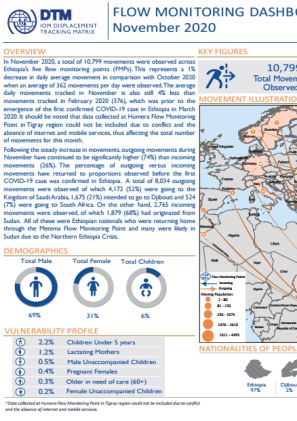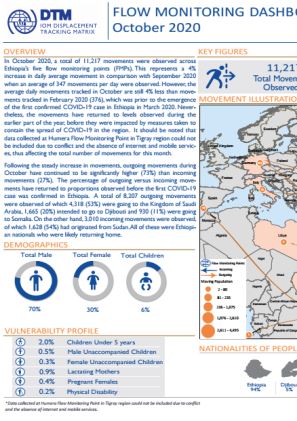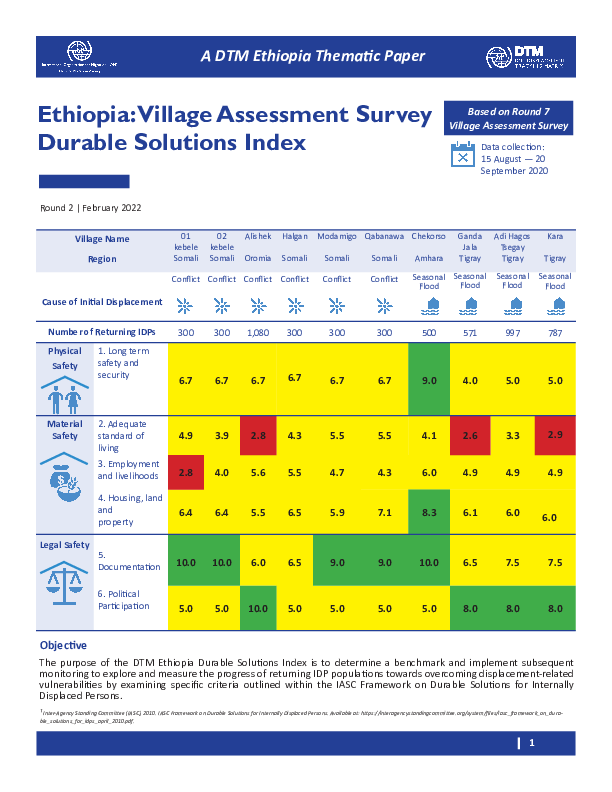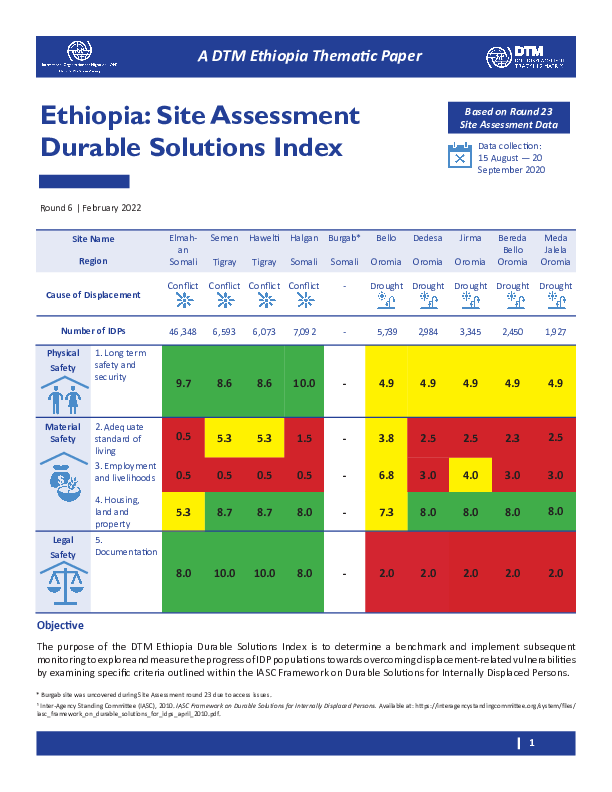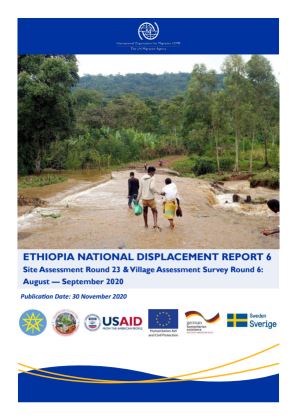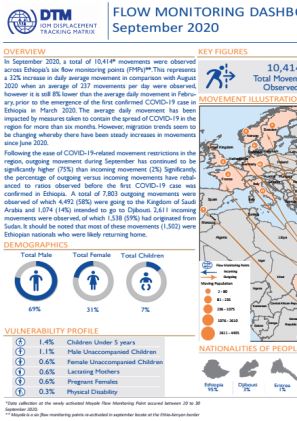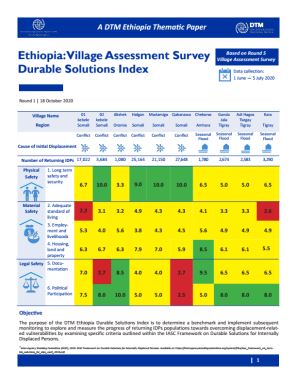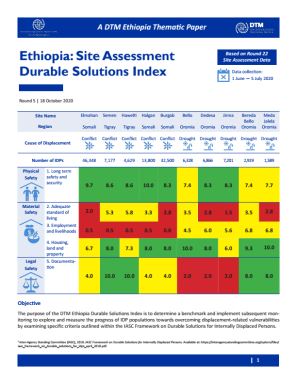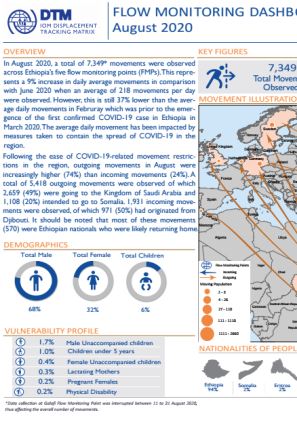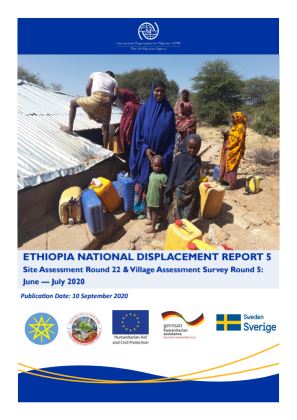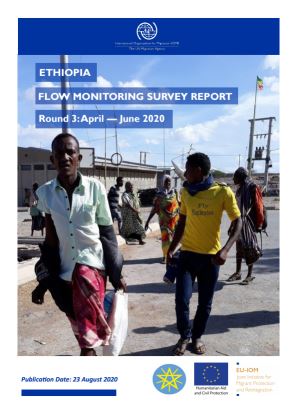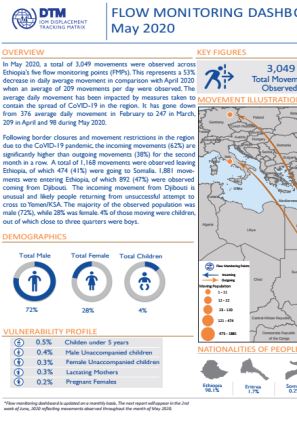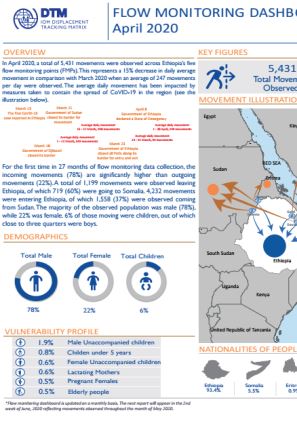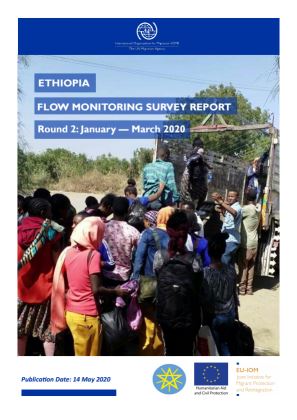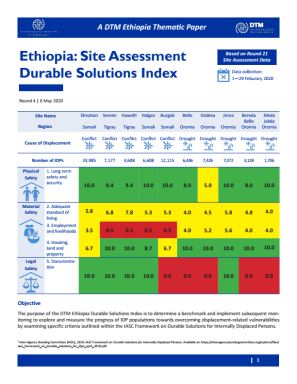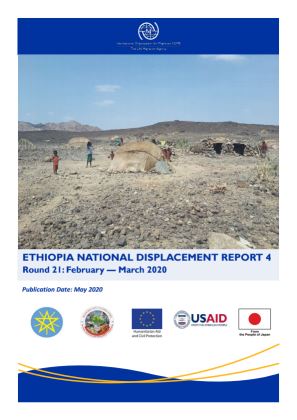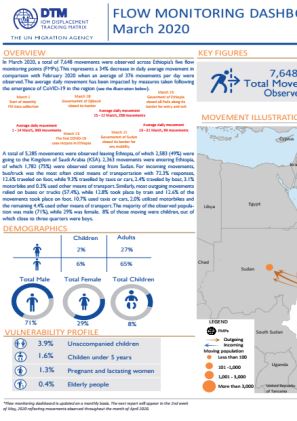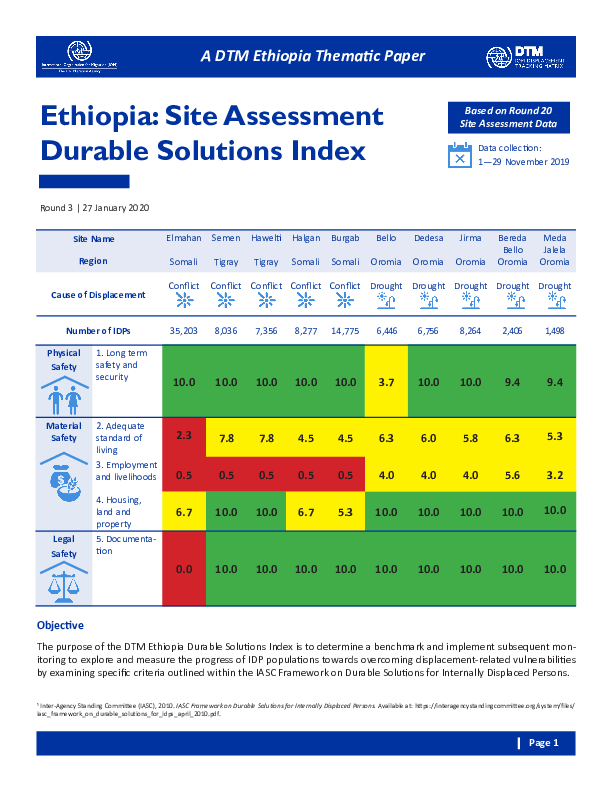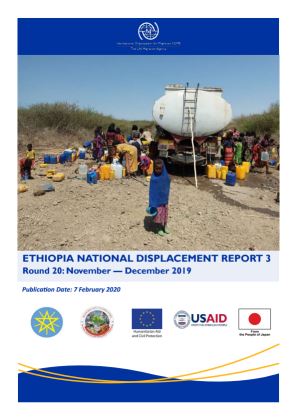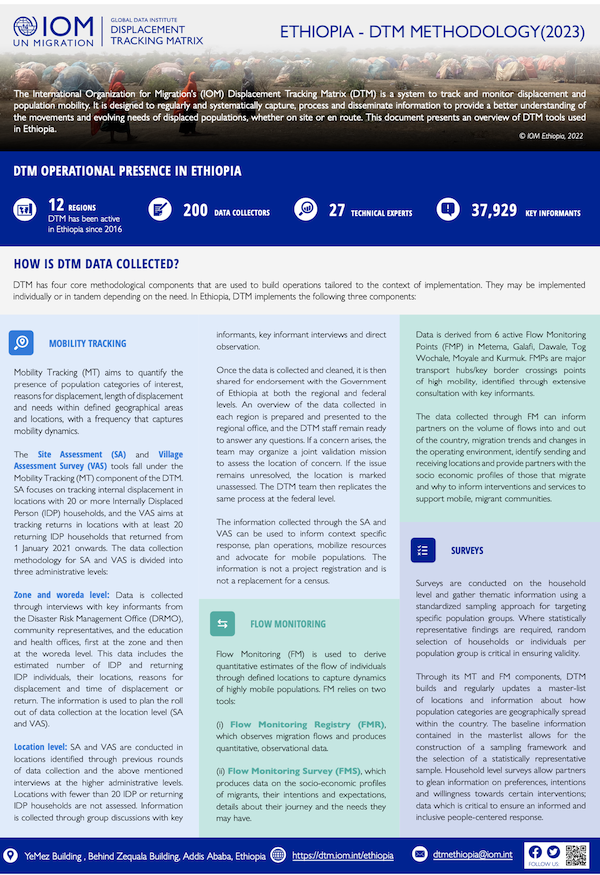-
Countries
-
Data and Analysis
-
Special Focus
-
Crisis Responses
Ethiopia
Error message
The submitted value field_published_date_value in the Sort by element is not allowed.
About Ethiopia
Ethiopia faces one of the most complex human mobility environments in the world, with a range of social, economic, political, and climatic factors driving populations within and outside its borders.
IOM’s Displacement Tracking Matrix (DTM) is a system that monitors human mobility within Ethiopia to provide essential insights into the location, vulnerabilities, demographic breakdown and needs of displaced and mobile populations to provide the Government of Ethiopia, humanitarian and development partners, as well as donors and other relevant stakeholders with a useful evidence base for planning, advocacy, and response.
Since its launch in September 2016 in Ethiopia, the DTM has grown to be a fully integrated component of Ethiopia’s national and sub-national information management architecture, as it is the official source of data on internal displacement in the country.
In Ethiopia, mobility tracking captures internal displacement and return through three annual rounds of Site Assessments (focused on IDPs and the availability of services in their areas of displacement) as well as returning IDPs through the Village Assessment Surveys (focused on host community capacity to absorb returns targeting IDPs, returning IDPs, returned migrants and host community members and their access to services with a focus on livelihoods and reintegration). Mobility tracking data is largely used to inform humanitarian response and development planning and as such is coordinated with both humanitarian and development actors in country as well as with the Ethiopia Disaster Risk Management Commission. Flow Monitoring captures inter-and intra-regional migration flows daily at key identified transit locations. This information is largely used to inform more developmental programming including migrant assistance and protection programming. This data is also shared with humanitarian and development counterparts in the country and is collected in close coordination with the Ministry of Labor and Social Affairs. Both DTM components intend to provide an evidence-base for programming and policy that is increasingly integrated and area-based. In addition to mobility tracking and flow monitoring, DTM Ethiopia also deploys thematic household level surveys to provide representative, granular information which can be triangulated with pre-existing DTM data collected through key informants and focus group discussions. This data enables the humanitarian and development communities to obtain important insight into the needs, conditions, vulnerabilities, and intentions of IDPs which can be particularly useful in informing programs, especially with regards to durable solutions, livelihoods, and other Humanitarian Development Nexus (HDN) related programming and policy initiatives.
DTM Ethiopia currently deploys over 200 staff and enumerators to track displacement, returns and migrant movements in the country.
Current Donors
- USAID
- ECHO
- Canada
- Japan
- EHF
Ethiopia — Flow Monitoring Dashboard 15 (December 2020)
In December 2020, a total of 14,984 movements were observed across Ethiopia’s five flow monitoring points (FMPs) whereby outgoing movements have continued to be significantly higher (77%) than incoming movements (23%).
Ethiopia — Flow Monitoring Dashboard 14 (November 2020)
In November 2020, a total of 10,799 movements were observed across Ethiopia’s five flow monitoring points (FMPs) whereby outgoing movements have continued to be significantly higher (74%) than incoming movements (26%).
Ethiopia — Flow Monitoring Dashboard 13 (October 2020)
In October 2020, a total of 11,217 movements were observed across Ethiopia’s five flow monitoring points (FMPs). This represents a 4% increase in daily average movement in comparison with September 2020 when an average of 347 movements per day were observed.
Ethiopia — Thematic Paper: Village Assessment Survey Durable Solutions Index Report 2
The DTM Ethiopia Village Assessment Survey Durable Solutions Index Report measures the progress of returning IDP populations towards overcoming displacement-related vulnerabilities by examining specific criteria outlined within the IASC Framework on Durable Solutions for Internally Displaced Pers
Ethiopia — Thematic Paper: Site Assessment Durable Solutions Index Report 6
The DTM Ethiopia Site Assessment Durable Solutions Index Report measures the progress of IDP populations towards overcoming displacement-related vulnerabilities by examining specific criteria outlined within the IASC Framework on Durable Solutions for Internally Displaced Persons.
Ethiopia — National Displacement Report 6 (August — September 2020)
In order to capture the displacement and return dynamics in Ethiopia, DTM Ethiopia's National Displacement Report combines findings from its Site Assessment (SA) in Section 1 and findings from the Village Assessment Survey (VAS) in Section 2.
Ethiopia — Flow Monitoring Dashboard 12 (September 2020)
In September 2020, a total of 10,414* movements were observed across Ethiopia’s six flow monitoring points (FMPs).
Ethiopia — Thematic Paper: Village Assessment Survey Durable Solutions Index Report 1
The DTM Ethiopia Village Assessment Survey Durable Solutions Index Report measures the progress of returning IDP populations towards overcoming displacement-related vulnerabilities by examining specific criteria outlined within the IASC Framework on Durable Solutions for Internally Displace
Ethiopia — Thematic Paper: Site Assessment Durable Solutions Index Report 5
The DTM Ethiopia Site Assessment Durable Solutions Index Report measures the progress of IDP populations towards overcoming displacement-related vulnerabilities by examining specific criteria outlined within the IASC Framework on Durable Solutions for Internally Displaced Persons.
Ethiopia — Flow Monitoring Dashboard 11 (August 2020)
In August 2020, a total of 7,349 movements were observed across Ethiopia’s five flow monitoring points (FMPs). This represents a 9% increase in daily average movements in comparison with June 2020 when an average of 218 movements per day were observed.
Ethiopia — National Displacement Report 5 (June — July 2020)
In order to capture the displacement and return dynamics in Ethiopia, DTM Ethiopia's National Displacement Report combines findings from its Site Assessment (SA) in Section 1 and findings from the Village Assessment Survey (VAS) in Section 2.
Ethiopia — Flow Monitoring Survey Report 3 (April — June 2020)
Between 1 April to 30 June 2020, DTM Ethiopia surveyed a total of 907 migrants across 5 Flow Monitoring Points (FMPs).
Ethiopia — Flow Monitoring Dashboard 10 (June 2020)
In June 2020, a total of 6,525 movements were observed across Ethiopia’s five flow monitoring points (FMPs). This represents a 122% increase in daily average movement in comparison with May 2020 when an average of 98 movements per day were observed.
Ethiopia — Flow Monitoring Dashboard 9 (May 2020)
In May 2020, a total of 3,049 movements were observed across Ethiopia’s five flow monitoring points (FMPs). This represents a 53% decrease in daily average movement in comparison with April 2020 when an average of 209 movements per day were observed.
Ethiopia — Flow Monitoring Dashboard 8 (April 2020)
In April 2020, a total of 5,431 movements were observed across Ethiopia's five flow monitoring points (FMPs).
Ethiopia — Flow Monitoring Survey Report 2 (January — March 2020)
Between 1 January to 31 March 2020, DTM Ethiopia surveyed a total of 1,325 migrants across five Flow Monitoring Points (FMPs). These FMPs are located in Humera, Metema, Galafi, Dawale and Tog Wochale.
Ethiopia — Thematic Paper: Site Assessment Durable Solutions Index Report 4
The DTM Ethiopia Site Assessment Durable Solutions Index Report measures the progress of IDP populations towards overcoming displacement-related vulnerabilities by examining specific criteria outlined within the IASC Framework on Durable Solutions for Internally Displaced Persons.
Ethiopia — National Displacement Report 4 (February — March 2020)
In order to capture the displacement and mobility dynamics in Ethiopia, DTM Ethiopia's National Displacement Report combines its findings from its Site Assessment (SA) in Section 1 and findings from the Village Assessment Survey (VAS) in Section 2.
Ethiopia — Flow Monitoring Dashboard 7 (March 2020)
In March 2020, a total of 7,648 movements were observed across Ethiopia's five flow monitoring points (FMPs).
Ethiopia — Flow Monitoring Dashboard 6 (February 2020)
In February 2020, a total of 10,907 movements were observed across Ethiopia’s five flow monitoring points (FMPs). This represents a 5% increase in daily average movement in comparison with January 2020 when an average of 359 movements per day were observed.
Ethiopia — Flow Monitoring Survey Report 1 (October — December 2019)
Between 1 October to 31 December 2019, DTM Ethiopia surveyed a total of 1,703 migrants across five Flow Monitoring Points (FMPs). These FMPs are located in Humera, Metema, Galafi, Dawale and Tog Wochale.
Ethiopia — Flow Monitoring Dashboard 5 (January 2020)
In January 2020, a total of 11,137 movements were observed across Ethiopia’s five flow monitoring points (FMPs). This represents a 7% increase in daily average movement in comparison with December 2019 when an average of 336 movements per day were observed.
Ethiopia — Thematic Paper: Site Assessment Durable Solutions Index Report 3
The DTM Ethiopia Site Assessment Durable Solutions Index Report measures the progress of IDP populations towards overcoming displacement-related vulnerabilities by examining specific criteria outlined within the IASC Framework on Durable Solutions for Internally Displaced Persons.
Ethiopia — National Displacement Report 3 (November — December 2019)
In order to capture the displacement and mobility dynamics in Ethiopia, DTM Ethiopia's National Displacement Report combines its findings from its Site Assessment (SA) in Section 1 and findings from the Village Assessment Survey (VAS) in Section 2.
Pagination
Ethiopia — Site Assessment Round 9
2018-02-06
A site assessment is a sub-component of mobility tracking. It aims to collect data on population presence, living conditions and needs in a particular displacement site or community.
Ethiopia - Site Assessment Round 8
2017-12-31
A site assessment is a sub-component of mobility tracking. It aims to collect data on population presence, living conditions and needs in a particular displacement site or community.
Ethiopia - B1F Baseline Assessment Round 8
2017-12-31
A baseline assessment is a sub-component of mobility tracking. It aims to collect data on IDP, migrant or returnee population presence in a defined administrative area of the country.



